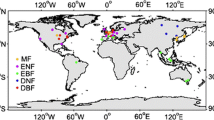Abstract
This study investigated the flux-variance relationships of temperature, humidity, and CO2, and examined the performance of using this method for predicting sensible heat (H), water vapor (LE), and CO2 fluxes (FCO2) with eddy-covariance measured flux data at three different ecosystems: grassland, paddy rice field, and forest. The H and LE estimations were found to be in good agreement with the measurements over the three fields. The prediction accuracy of LE could be improved by around 15% if the predictions were obtained by the flux-variance method in conjunction with measured sensible heat fluxes. Moreover, the paddy rice field was found to be a special case where water vapor follows flux-variance relation better than heat does. However, the CO2 flux predictions were found to vary from poor to fair among the three sites. This is attributed to the complicated CO2 sources and sinks distribution. Our results also showed that heat and water vapor were transported with the same efficiency above the grassland and rice paddy. For the forest, heat was transported 20% more efficiently than evapotranspiration.













Similar content being viewed by others
References
Andreas EL, Hill RJ, Gosz JR, Moore DI, Otto WD, Sarma AD (1998) Statistics of surface layer turbulence over terrain with meter-scale heterogeneity. Boundary-Layer Meteorol 86:379–408
Asanuma J, Brutsaert W (1999) Turbulence variance characteristics of temperature and humidity in the unstable atmospheric surface layer above a variable pine forest. Water Resour Res 35:2281–2288
Campbell GS, Norman JM (1998) An introduction to environmental biophysics, 2nd edn. Springer, New York
Castellvi F, Martinez-Cob A (2005) Estimation sensible heat flux using surface renewal analysis and the flux variance method: a case study over olive trees at Sastago (NE of Spain). Water Resour Res 41:W09422
de Bruin HAR, Kohsiek W, Van Den Hurk BJJM (1993) A verification of some methods to determine the fluxes of momentum, sensible heat, and water vapor using standard deviation and structure parameter of scalar meteorological quantities. Boundary-Layer Meteorol 63:231–257
Detto M, Katul GG (2007) Simplified expressions for adjusting higher-order turbulent statistics obtained from open path gas analyzers. Boundary-Layer Meteorol 122:205–216
Gao Z, Bian L, Chen Z, Sparraw M, Zhang J (2006) Turbulent variance characteristics of temperature and humidity over a non-uniform land surface for an agriculture ecosystem in China. Adv Atmos Sci 23:365–374
Hsieh CI Katul GG, Sigmon J, Knoerr KR (1996) Estimation of momentum and heat fluxes using dissipation and flux-variance methods in the unstable surface layer. Water Resour Res 32:2453–2462
Hsieh CI, Katul GG, Chi TW (2000) An approximate analytical model for footprint estimation of scalar fluxes in thermally stratified atmospheric flows. Adv Water Resour 23:765–772
Hsieh CI, Kiely G, Birkby A, Katul G (2005) Photosynthetic responses of a humid grassland ecosystem to future climate perturbations. Adv Water Resour 28:910–916
Jaksic V, Kiely G, Albertson J, Oren R, Katul G, Leahy P, Byrne KA (2006) Net ecosystem exchange of grassland in contrasting wet and dry years. Agri For Meteorol 139:323–334
Katul GG, Goltz M, Hsieh C, Cheng Y, Mowry F, Sigmon J (1995) Estimation of surface heat and momentum fluxes using the flux-variance method above uniform and non-uniform terrain. Boundary-Layer Meteorol 74:237–260
Lamaud E, Irvine M (2006) Temperature-humidity dissimilarity and heat-to-water vapor transport efficiency above and within a pine forest canopy: the role of the Bowen ratio. Boundary-Layer Meteorol 120:87–109
Lloyd CR, Culf AD, Dolman AJ, Gash JH (1991) Estimates of sensible heat flux from observations of temperature fluctuations. Boundary-Layer Meteorol 57:311–322
McBean GA, Miyake M (1972) Turbulent transfer mechanisms in the atmospheric surface layer. Quart J R Meteorol Soc 98:383–398
McMillen R (1988) An eddy correlation technique with extended applicability to non-simple terrain. Boundary-Layer Meteorol 43:231–245
Michiaki S, Noriaki K (2003) Surface and mixed-layer variance methods to estimate regional sensible heat flux at the surface. Boundary-Layer Meteorol 106:117–145
Moore CJ (1986) Frequency response corrections for eddy correlation systems. Boundary-Layer Meteorol 37:17–35
Moriwaki M, Kanda M (2006) Local and global similarity in turbulent transfer of heat, water vapor, and CO2 in the dynamic convective sublayer over a suburban area. Boundary-Layer Meteorol 120:163–179
Ohtaki E (1985) On the similarity in atmospheric fluctuations of carbon dioxide, water vapor and temperature over vegetated fields. Boundary-Layer Meteorol 32:25–37
Padro J (1993) An investigation of flux-variance methods and universal functions applied to three land-use types in unstable conditions. Boundary-Layer Meteorol 66:413–425
Tillman JE (1972) The indirect determination of stability, heat and momentum fluxes in the atmosphere boundary layer from simple scalar variables during dry unstable conditions. J Appl Meteorol 44:13–31
Weaver HL (1990) Temperature and humidity flux-variance relarions determined by one-dimensional eddy correlations. Boundary-Layer Meteorol 53:77–91
Webb EK, Perman GI, Leuning R (1980) Correction of flux measurements for density effects due to heat and water transfer. Quart J R Meteorol Soc 106:85–100
Wesely ML (1988) Use of variance techniques to measure dry air-surface exchange rates. Boundary-Layer Meteorol 44:13–31
Wesson KH, Katul GG, Lai CT (2001) Sensible heat flux estimation by flux variance and half-order time derivative methods. Water Resour Res 37:2333–2343
Wilczak JM, Oncley SP, Stage SA (2001) Sonic anemometer tilt correction algorithms. Boundary-Layer Meteorol 99:127–150
Williams CA, Scanlon TM, Albertson JD (2007) Influence of surface heterogeneity on scalar dissimilarity in the roughness sublayer. Boundary-Layer Meteorol 122:149–165
Acknowledgments
The authors would like to thank the National Science Council and Environmental Protection Agency, Taiwan, for their support of this study. We are also very grateful to Professor Gerard Kiely for his data support and the two reviewers for their helpful comments.
Author information
Authors and Affiliations
Corresponding author
Rights and permissions
About this article
Cite this article
Hsieh, CI., Lai, MC., Hsia, YJ. et al. Estimation of sensible heat, water vapor, and CO2 fluxes using the flux-variance method. Int J Biometeorol 52, 521–533 (2008). https://doi.org/10.1007/s00484-008-0149-4
Received:
Revised:
Accepted:
Published:
Issue Date:
DOI: https://doi.org/10.1007/s00484-008-0149-4



